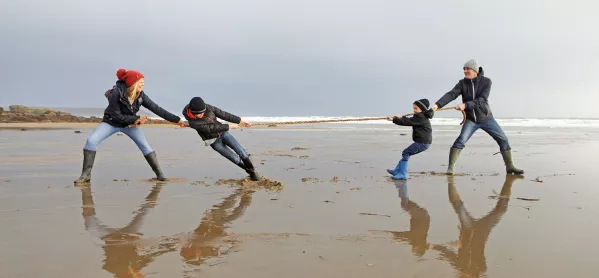- Home
- 4 ways PE could become a key part of family life
4 ways PE could become a key part of family life

Post-coronavirus much about physical education will have to change.
If nothing else, a two- or even one-metre distancing rule may make many former staples of PE lessons unfeasible.
This could seem daunting, but there’s a positive from this situation, which so far has been overlooked - it could mean that PE turns sport into a family-orientated activity that adapts to the new world that has grown up around us.
PE in the coronavirus crisis: Family time together
Whereas before parents would rush around dropping one child off at football practice and then taking another to dance class and then picking them all up in an hour’s time, now there is an appreciation of “active family time together”, looking outside in our own communities and making the most of nature and the great outdoors.
More families are walking together as a unit and more families are biking, running and setting aside time to be active together.
This may change when things return to normal but the hope will be that the fun and enjoyment this has caused for many remains.
The role of PE
Schools can help with this, too.
Indeed, PE teachers perhaps have an obligation to continue this good practice and educate students on the importance of being physically active with their families.
It would certainly link well with most PE department’s target of creating “lifelong learners/ participants”.
Perhaps PE teachers should be putting more energy into teaching sports that are family-friendly? Sports that mum, dad, son, daughter and even grandma can be involved in.
Can this sporting unit not only tick the box of physical activity but also help to combat issues such as the lack of community identity and spirit, reduce mental health problems, improve social wellbeing, tackle obesity and increase sports participation outside schools?
Would this shift of focus also pave the way for a more understanding PE curriculum where the whole student (in and out of school) is thought about and developed?
It’s a powerful thought.
If we are to make it happen, there are four fundamentals that PE practitioners can start thinking about.
1. This should be a unit about education and not participation
Appreciate that everyone’s families are different, and maybe not set up for “active involvement” at this time. That’s OK - don’t make participation compulsory. The theory part, though, is valuable to everyone.
2. Communicate your ideas to parents - get them on board
Maybe invite them in for a coffee morning or do an online webinar explaining the benefit of family active time. You’ll be amazed with the response.
3. Tell everyone the goals you want to achieve from this unit
When everyone knows, then, in a weird way, you can be sure that they’ll help make it happen. Make it a community goal, not a PE one or even a school one.
Use this to bridge the gap between schools and the community - we all know how much better things are when parents are on our side.
4. Use other people and other departments
If you make this just about PE, you’re missing the point.
For example, if you want to organise a local orienteering course in your town for students to be active with their families while learning about their community, then use the geography department for mapping the course, the history department for the local information and maybe the IT department to create the social media content to promote it.
By sharing the experience, it adds value to what you are trying to achieve - it doesn’t take anything away. The more the merrier. But you must still orchestrate the event and keep everyone close to your targets and goals.
What have we got to lose?
There will always be opportunities in the future to revert back to the “good old days” of PE teaching. Those ways are perfectly acceptable, well tested and valuable in a child’s sporting development.
What I’m suggesting instead is to use this time to reach out further than the sports hall and playing field. To reach outside of your school and show the wider community the true benefits of being lifelong participants in physical education. To show the exceptional core values that are attached to our subject, such as resilience, determination, respect and cooperation to name a few.
Why not give it a go - what’s the worst that could happen?
Steve Williams was a head of PE in England in mainstream and SEND settings for eight years until he relocated to Vietnam to create PE programmes for the international sector. He currently works as head of PE in a large international school in Malaysia, where he has been living for the past two years
Keep reading for just £1 per month
You've reached your limit of free articles this month. Subscribe for £1 per month for three months and get:
- Unlimited access to all Tes magazine content
- Exclusive subscriber-only stories
- Award-winning email newsletters